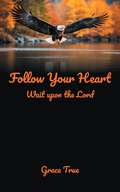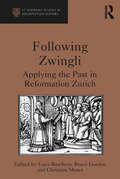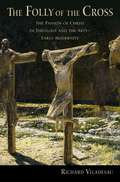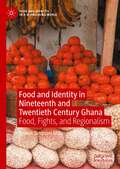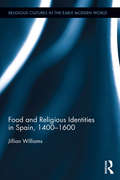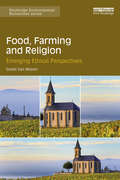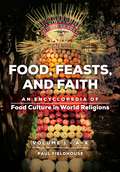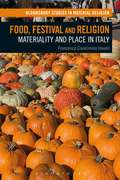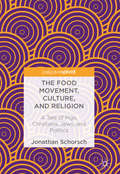- Table View
- List View
Follow Your Conscience: The Catholic Church and the Spirit of the Sixties
by Peter CajkaWhat is your conscience? Is it, as Peter Cajka asks in this provocative book, “A small, still voice? A cricket perched on your shoulder? An angel and devil who compete for your attention?” Going back at least to the thirteenth century, Catholics viewed their personal conscience as a powerful and meaningful guide to align their conduct with worldly laws. But, as Cajka shows in Follow Your Conscience, during the national cultural tumult of the 1960s, the divide between the demands of conscience and the demands of the law, society, and even the church itself grew increasingly perilous. As growing numbers of Catholics started to consider formerly stout institutions to be morally hollow—especially in light of the Vietnam War and the church’s refusal to sanction birth control—they increasingly turned to their own consciences as guides for action and belief. This abandonment of higher authority had radical effects on American society, influencing not only the broader world of Christianity, but also such disparate arenas as government, law, health care, and the very vocabulary of American culture. As this book astutely reveals, today’s debates over political power, religious freedom, gay rights, and more are all deeply infused by the language and concepts outlined by these pioneers of personal conscience.
Follow Your Conscience: The Catholic Church and the Spirit of the Sixties
by Peter CajkaWhat is your conscience? Is it, as Peter Cajka asks in this provocative book, “A small, still voice? A cricket perched on your shoulder? An angel and devil who compete for your attention?” Going back at least to the thirteenth century, Catholics viewed their personal conscience as a powerful and meaningful guide to align their conduct with worldly laws. But, as Cajka shows in Follow Your Conscience, during the national cultural tumult of the 1960s, the divide between the demands of conscience and the demands of the law, society, and even the church itself grew increasingly perilous. As growing numbers of Catholics started to consider formerly stout institutions to be morally hollow—especially in light of the Vietnam War and the church’s refusal to sanction birth control—they increasingly turned to their own consciences as guides for action and belief. This abandonment of higher authority had radical effects on American society, influencing not only the broader world of Christianity, but also such disparate arenas as government, law, health care, and the very vocabulary of American culture. As this book astutely reveals, today’s debates over political power, religious freedom, gay rights, and more are all deeply infused by the language and concepts outlined by these pioneers of personal conscience.
Follow Your Heart: Wait upon the Lord
by Grace TrueFollow Your Heart is a novel that portrays a friendship that develops in the beautiful direction of love. Jason, an intelligent man with a successful career who lives with his very faithful devoted mum, finds true friendship when he meets Audrey. She is a young lady that lives with her two aunties and works at the hospital as a nurse. Having common friends, they meet and enjoy each other's company. When an unexpected opportunity comes by, she choses to move as she is not sure that a successful man like Jason would have time for her. Being apart, she realizes that she would love to try to move forward and keep meeting Jason and was no point hiding her feelings for him. The truth always sets free and, having a good conversation, and dealing with their feelings, they decide to date. The Lord is leading them on a new path of being together, in spite of Jason losing his mum and being on a new path with the Lord. Working together, they are learning how to walk this journey of love as a couple.
The Followers of Jesus as the 'Servant': Luke’s Model from Isaiah for the Disciples in Luke-Acts (The Library of New Testament Studies #535)
by Holly BeersLuke models his portrayal both of Jesus and his disciples in Luke-Acts after the human agent of the Isaianic New Exodus in Isaiah 40-66, the servant. In the Isaianic New Exodus the servant is integral to the restoration; the servant's mission being embodied is, to a great extent, how the New Exodus comes to fruition.The servant connection is at times explicit, as Jesus is identified with the servant in Luke 4:18-19 (quoting Isa 61:1-2 [with 58:6]); Luke 22:37 (citing Isa 53:12); and Acts 8:32-33 (Isa 53:7-8). Regarding the disciples, Isa 49:6 is quoted by Paul in Acts 13:47 in reference to himself and Barnabas, though a focus only on quotations is too limiting. Allusions to servant passages abound. This work argues that Luke sees Jesus fulfilling the servant role in an ultimate sense, but that his followers, modelled after him in Acts, also embody it. This can be seen in Luke's use of Isaianic servant imagery, including suffering, lack of violent response (to unjust treatment) and language in the disciples' characterization.
Following Muhammad: Rethinking Islam in the Contemporary World (Islamic Civilization and Muslim Networks)
by Carl W. ErnstAvoiding the traps of sensational political exposes and specialized scholarly Orientalism, Carl Ernst introduces readers to the profound spiritual resources of Islam while clarifying diversity and debate within the tradition. Framing his argument in terms of religious studies, Ernst describes how Protestant definitions of religion and anti-Muslim prejudice have affected views of Islam in Europe and America. He also covers the contemporary importance of Islam in both its traditional settings and its new locations and provides a context for understanding extremist movements like fundamentalism. He concludes with an overview of critical debates on important contemporary issues such as gender and veiling, state politics, and science and religion.
Following the Moon: From the international bestselling author of Big Panda and Tiny Dragon
by James NorburyFROM THE GLOBAL BESTSELLING AUTHOR OF BIG PANDA, TINY DRAGAN AND THE CAT WHO TAUGHT ZEN Read the beautifully illustrated, heartfelt tale of a wise and aged wolf who takes a young, lost pup on an unforgettable journey.----There are times when we have done everything we can do. Then we must learn to step back and allow the universe to play out in all its unfathomable wonder. . .Deep in the silent mountains wanders Amaya, a lost pup searching for her parents after a terrible snowstorm which, for the first time in her life, leaves her alone.Until she meets a wise and aged wolf who, having saved her life, becomes her guide on an unforgettable adventure to follow the moon.As they make their way through day and night across a wintery landscape, together they both learn profound lessons about love, sacrifice, life, loss and ultimately change.James’s books and illustrations have inspired millions around the world, touching deep spiritual chords with readers. In this, his fourth book, he takes readers, old and new, on a quest that will stay with them forever.----PRAISE FOR JAMES NORBURY'James has a way to speak to your soul' VEX KING'While the drawings have the charm of Winnie-the-Pooh, the captions have the depth of ancient proverbs' GUARDIAN'A beautifully illustrated book which draws on tender moments. Exquisite' DR RANGAN CHATTERJEE
Following the Way of Jesus: A clarion call to join the Jesus movement
by Bishop Michael CurryMichael Curry leads off with a clarion call for us to join the Jesus Movement. A team of the Episcopal Church's brightest stars follow up with reflections on the practice of ministry in light of the movement: Sara Miles on encountering the "other," Rob Wright on adaptive leadership, Broderick Greer on reconciliation, Anthony Guillen on new ministries, Megan Castellan on evangelism, and Kellan Day on ministry with young people. Diana Butler Bass closes with a word on making the world whole. Christians have been following Jesus together for some 2000 years - these leaders help to illuminate how we follow him in our time.
Following Zwingli: Applying the Past in Reformation Zurich
by Bruce Gordon Luca BascheraFollowing Zwingli explores history, scholarship, and memory in Reformation Zurich. The humanist culture of this city was shaped by a remarkable sodality of scholars, many of whom had been associated with Erasmus. In creating a new Christian order, Zwingli and his colleagues sought biblical, historical, literary, and political models to shape and defend their radical reforms. After Zwingli’s sudden death, the next generation was committed to the institutional and intellectual establishment of the Reformation through ongoing dialogue with the past. The essays of this volume examine the immediacy of antiquity, early Christianity, and the Middle Ages for the Zurich reformers. Their reading and appropriation of history was no mere rhetorical exercise or polemical defence. The Bible, theology, church institutions, pedagogy, and humanist scholarship were the lifeblood of the Reformation. But their appropriation depended on the interplay of past ideals with the pressing demands of a sixteenth-century reform movement troubled by internal dissention and constantly under attack. This book focuses on Zwingli’s successors and on their interpretations of the recent and distant past: the choices they made, and why. How those pasts spoke to the present and how they were heard tell us a great deal not only about the distinctive nature of Zurich and Zwinglianism, but also about locality, history, and religious change in the European Reformation.
Following Zwingli: Applying the Past in Reformation Zurich (St Andrews Studies In Reformation History Ser.)
by Bruce Gordon Luca BascheraFollowing Zwingli explores history, scholarship, and memory in Reformation Zurich. The humanist culture of this city was shaped by a remarkable sodality of scholars, many of whom had been associated with Erasmus. In creating a new Christian order, Zwingli and his colleagues sought biblical, historical, literary, and political models to shape and defend their radical reforms. After Zwingli’s sudden death, the next generation was committed to the institutional and intellectual establishment of the Reformation through ongoing dialogue with the past. The essays of this volume examine the immediacy of antiquity, early Christianity, and the Middle Ages for the Zurich reformers. Their reading and appropriation of history was no mere rhetorical exercise or polemical defence. The Bible, theology, church institutions, pedagogy, and humanist scholarship were the lifeblood of the Reformation. But their appropriation depended on the interplay of past ideals with the pressing demands of a sixteenth-century reform movement troubled by internal dissention and constantly under attack. This book focuses on Zwingli’s successors and on their interpretations of the recent and distant past: the choices they made, and why. How those pasts spoke to the present and how they were heard tell us a great deal not only about the distinctive nature of Zurich and Zwinglianism, but also about locality, history, and religious change in the European Reformation.
The Folly of the Cross: The Passion of Christ in Theology and the Arts in Early Modernity
by Richard ViladesauThe Folly of the Cross is the fourth book in Richard Viladesau's series examining the aesthetics and theology of the cross through Christian history. Previous volumes have brought the story up through the Baroque era. This new book examines the reception of the message of the cross from the European Enlightenment to the turn of the twentieth century. The opening chapters set the stage in the transition from the Baroque to the Classical eras, describing the changing intellectual and cultural paradigms of the time. Viladesau examines the theology of the cross in the eighteenth and nineteenth centuries, and the aesthetic mediation of the cross in music and the visual arts. He shows how in the post-Enlightenment era the aesthetic treatment of the cross widely replaced the dogmatic treatment, and how this thought was translated into popular spirituality, piety, and devotion. The Folly of the Cross shows how classical theology responded to the critiques of modern science, history, Biblical scholarship, and philosophy, and how both classical and modern theology served as the occasions for new forms of representation of Christ's passion in the arts and music.
FOLLY OF THE CROSS C: The Passion of Christ in Theology and the Arts in Early Modernity
by Richard ViladesauThe Folly of the Cross is the fourth book in Richard Viladesau's series examining the aesthetics and theology of the cross through Christian history. Previous volumes have brought the story up through the Baroque era. This new book examines the reception of the message of the cross from the European Enlightenment to the turn of the twentieth century. The opening chapters set the stage in the transition from the Baroque to the Classical eras, describing the changing intellectual and cultural paradigms of the time. Viladesau examines the theology of the cross in the eighteenth and nineteenth centuries, and the aesthetic mediation of the cross in music and the visual arts. He shows how in the post-Enlightenment era the aesthetic treatment of the cross widely replaced the dogmatic treatment, and how this thought was translated into popular spirituality, piety, and devotion. The Folly of the Cross shows how classical theology responded to the critiques of modern science, history, Biblical scholarship, and philosophy, and how both classical and modern theology served as the occasions for new forms of representation of Christ's passion in the arts and music.
Font of Pardon and New Life: John Calvin and the Efficacy of Baptism (Oxford Studies in Historical Theology)
by Lyle D. BiermaFont of Pardon and New Life is a study of the historical development and impact of John Calvin's doctrine of baptism, both adult (or believer) baptism and infant baptism. Did Calvin intend to teach a kind of baptismal forgiveness and regeneration, that is, did he believe that the external sign of baptism actually conveys the spiritual realities it signifies? If baptism does serve in some way as an instrument of divine grace for Calvin, what then are the roles of the Word, the Holy Spirit, divine election, and individual faith? Are spiritual blessings conferred only in adult (believer) baptism or also in the baptism of infants? Did Calvin's teaching on baptismal efficacy remain constant throughout his lifetime, or did it undergo significant change? What impact did it have on the Reformed confessional tradition that followed him? Lyle D. Bierma approaches these questions by examining Calvin's writings on baptism in their entirety, proceeding chronologically through Calvin's life and writings including his Institutes, commentaries on the Bible, catechisms, polemical treatises, and consensus documents. Bierma concludes that Calvin understood baptism as a means or instrument of both assurance and grace. His view underwent some change and development over the course of his life but not to the extent that some in the past have suggested. The overall trajectory of his baptismal theology was one of increasing clarity and refinement of basic themes already present in incipient form in the Institutes of 1536.
Font of Pardon and New Life: John Calvin and the Efficacy of Baptism (Oxford Studies in Historical Theology)
by Lyle D. BiermaFont of Pardon and New Life is a study of the historical development and impact of John Calvin's doctrine of baptism, both adult (or believer) baptism and infant baptism. Did Calvin intend to teach a kind of baptismal forgiveness and regeneration, that is, did he believe that the external sign of baptism actually conveys the spiritual realities it signifies? If baptism does serve in some way as an instrument of divine grace for Calvin, what then are the roles of the Word, the Holy Spirit, divine election, and individual faith? Are spiritual blessings conferred only in adult (believer) baptism or also in the baptism of infants? Did Calvin's teaching on baptismal efficacy remain constant throughout his lifetime, or did it undergo significant change? What impact did it have on the Reformed confessional tradition that followed him? Lyle D. Bierma approaches these questions by examining Calvin's writings on baptism in their entirety, proceeding chronologically through Calvin's life and writings including his Institutes, commentaries on the Bible, catechisms, polemical treatises, and consensus documents. Bierma concludes that Calvin understood baptism as a means or instrument of both assurance and grace. His view underwent some change and development over the course of his life but not to the extent that some in the past have suggested. The overall trajectory of his baptismal theology was one of increasing clarity and refinement of basic themes already present in incipient form in the Institutes of 1536.
Food and Identity in Nineteenth and Twentieth Century Ghana: Food, Fights, and Regionalism (Food and Identity in a Globalising World)
by Brandi Simpson MillerThis book investigates how cooking, eating, and identity are connected to the local micro-climates in each of Ghana’s major eco-culinary zones. The work is based on several years of researching Ghanaian culinary history and cuisine, including field work, archival research, and interdisciplinary investigation. The political economy of Ghana is used as an analytical framework with which to investigate the following questions: How are traditional food production structures in Ghana coping with global capitalist production, distribution, and consumption? How do land, climate, and weather structure or provide the foundation for food consumption and how does that affect the separate traditional and capitalist production sectors? Despite the post WWII food fight that launched Ghana’s bid for independence from the British empire, Ghana’s story demonstrates the centrality of local foods and cooking to its national character. The cultural weight of regional traditional foods, their power to satisfy, and the overall collective social emphasis on the ‘proper’ meal, have persisted in Ghana, irrespective of centuries of trade with Europeans. This book will be of interest to scholars in food studies, comparative studies, and African studies, and is sure to capture the interest of students in new ways.
Food and Religious Identities in Spain, 1400-1600 (Religious Cultures in the Early Modern World)
by Jillian WilliamsIn the late fourteenth century, the Iberian Peninsula was home to three major religions which coexisted in relative peace. Over the next two centuries, various political and social factors changed the face of Iberia dramatically. This book examines this period of dynamic change in Iberian history through the lens of food and its relationship to religious identity. It also provides a basis for further study of the connection between food and identities of all types. This study explores the role of food as an expression of religious identity made evident in things like fasting, feasting, ingredient choices, preparation methods and commensal relations. It considers the role of food in the formation and redefinition of religious identities throughout this period and its significance in the maintenance of ideological and physical boundaries between faiths. This is an insightful and unique look into inter-religious dynamics. It will therefore be of great interest to scholars of religious studies, early modern European history and food studies.
Food and Religious Identities in Spain, 1400-1600 (Religious Cultures in the Early Modern World)
by Jillian WilliamsIn the late fourteenth century, the Iberian Peninsula was home to three major religions which coexisted in relative peace. Over the next two centuries, various political and social factors changed the face of Iberia dramatically. This book examines this period of dynamic change in Iberian history through the lens of food and its relationship to religious identity. It also provides a basis for further study of the connection between food and identities of all types. This study explores the role of food as an expression of religious identity made evident in things like fasting, feasting, ingredient choices, preparation methods and commensal relations. It considers the role of food in the formation and redefinition of religious identities throughout this period and its significance in the maintenance of ideological and physical boundaries between faiths. This is an insightful and unique look into inter-religious dynamics. It will therefore be of great interest to scholars of religious studies, early modern European history and food studies.
Food, Faith and Gender in South Asia: The Cultural Politics of Women's Food Practices (Criminal Practice Ser.)
by Nita Kumar Usha SanyalHow do women express individual agency when engaging in seemingly prescribed or approved practices such as religious fasting? How are sectarian identities played out in the performance of food piety? What do food practices tell us about how women negotiate changes in family relationships? This collection offers a variety of distinct perspectives on these questions. Organized thematically, areas explored include the subordination of women, the nature of resistance, boundary making and the construction of identity and community. Methodologically, the essays use imaginative reconstructions of women's experiences, particularly where the only accounts available are written by men. The essays focus on Hindus and Muslims in South Asia, Sri Lankan Buddhist women and South Asians in the diaspora in the US and UK. Pioneering new research into food and gender roles in South Asia, this will be of use to students of food studies, sociology, anthropology and cultural studies.
Food, Faith and Gender in South Asia: The Cultural Politics of Women's Food Practices
How do women express individual agency when engaging in seemingly prescribed or approved practices such as religious fasting? How are sectarian identities played out in the performance of food piety? What do food practices tell us about how women negotiate changes in family relationships? This collection offers a variety of distinct perspectives on these questions. Organized thematically, areas explored include the subordination of women, the nature of resistance, boundary making and the construction of identity and community. Methodologically, the essays use imaginative reconstructions of women's experiences, particularly where the only accounts available are written by men. The essays focus on Hindus and Muslims in South Asia, Sri Lankan Buddhist women and South Asians in the diaspora in the US and UK. Pioneering new research into food and gender roles in South Asia, this will be of use to students of food studies, sociology, anthropology and cultural studies.
Food, Farming and Religion: Emerging Ethical Perspectives (Routledge Environmental Humanities)
by Gretel Van WierenAlthough the religious and ethical consideration of food and eating is not a new phenomenon, the debate about food and eating today is distinctly different from most of what has preceded it in the history of Western culture. Yet the field of environmental ethics, especially religious approaches to environmental ethics, has been slow to see food and agriculture as topics worthy of analysis. This book examines how religious traditions and communities in the United States and beyond are responding to critical environmental ethical issues posed by the global food system. In particular, it looks at the responses that have developed within Jewish, Christian, and Islamic traditions, and shows how they relate to arguments and approaches in the broader study of food and environmental ethics. It considers topics such as land degradation and restoration, genetically modified organisms and seed consolidation, animal welfare, water use, access, pollution, and climate, and weaves consideration of human wellbeing and justice throughout. In doing so, Gretel Van Wieren proposes a model for conceptualizing agricultural and food practices in sacred terms. This book will appeal to a wide and interdisciplinary audience including those interested in environment and sustainability, food studies, ethics, and religion.
Food, Farming and Religion: Emerging Ethical Perspectives (Routledge Environmental Humanities)
by Gretel Van WierenAlthough the religious and ethical consideration of food and eating is not a new phenomenon, the debate about food and eating today is distinctly different from most of what has preceded it in the history of Western culture. Yet the field of environmental ethics, especially religious approaches to environmental ethics, has been slow to see food and agriculture as topics worthy of analysis. This book examines how religious traditions and communities in the United States and beyond are responding to critical environmental ethical issues posed by the global food system. In particular, it looks at the responses that have developed within Jewish, Christian, and Islamic traditions, and shows how they relate to arguments and approaches in the broader study of food and environmental ethics. It considers topics such as land degradation and restoration, genetically modified organisms and seed consolidation, animal welfare, water use, access, pollution, and climate, and weaves consideration of human wellbeing and justice throughout. In doing so, Gretel Van Wieren proposes a model for conceptualizing agricultural and food practices in sacred terms. This book will appeal to a wide and interdisciplinary audience including those interested in environment and sustainability, food studies, ethics, and religion.
Food, Feasts, and Faith [2 volumes]: An Encyclopedia of Food Culture in World Religions [2 volumes]
by Paul FieldhouseAn indispensable resource for exploring food and faith, this two-volume set offers information on food-related religious beliefs, customs, and practices from around the world.Why do Catholics eat fish on Fridays? Why are there retirement homes for aged cows in India? What culture holds ceremonies to welcome the first salmon? More than five billion people worldwide claim a religious identity that shapes the way they think about themselves, how they act, and what they eat. Food, Feasts, and Faith: An Encyclopedia of Food Culture in World Religions explores how the food we eat every day often serves purposes other than to keep us healthy and stay alive: we eat to express our faith and to adhere to ethnic or cultural traditions that are part of who we are. This book provides readers with an understanding of the rich world of food and faith. It contains more than 200 alphabetically arranged entries that describe the beliefs and customs of well-established major world religions and sects as well as those of smaller faith communities and new religious movements. The entries cover topics such as religious food rules, religious festivals and symbolic foods, and vegetarianism and veganism, as well as general themes such as rites of passage, social justice, hospitality, and compassion.Each entry on religion explains what the religious dietary laws and guidelines are and how these were interpreted and put into practice historically and in modern settings. The coverage also includes important festivals and feast days as well as significant religious figures and organizations. Additionally, some 160 sidebars provide examples and more detailed information as well as fun facts.
Food, Feasts, and Faith [2 volumes]: An Encyclopedia of Food Culture in World Religions [2 volumes]
by Paul FieldhouseAn indispensable resource for exploring food and faith, this two-volume set offers information on food-related religious beliefs, customs, and practices from around the world.Why do Catholics eat fish on Fridays? Why are there retirement homes for aged cows in India? What culture holds ceremonies to welcome the first salmon? More than five billion people worldwide claim a religious identity that shapes the way they think about themselves, how they act, and what they eat. Food, Feasts, and Faith: An Encyclopedia of Food Culture in World Religions explores how the food we eat every day often serves purposes other than to keep us healthy and stay alive: we eat to express our faith and to adhere to ethnic or cultural traditions that are part of who we are. This book provides readers with an understanding of the rich world of food and faith. It contains more than 200 alphabetically arranged entries that describe the beliefs and customs of well-established major world religions and sects as well as those of smaller faith communities and new religious movements. The entries cover topics such as religious food rules, religious festivals and symbolic foods, and vegetarianism and veganism, as well as general themes such as rites of passage, social justice, hospitality, and compassion.Each entry on religion explains what the religious dietary laws and guidelines are and how these were interpreted and put into practice historically and in modern settings. The coverage also includes important festivals and feast days as well as significant religious figures and organizations. Additionally, some 160 sidebars provide examples and more detailed information as well as fun facts.
Food, Festival and Religion: Materiality and Place in Italy (Bloomsbury Studies in Material Religion)
by Francesca Ciancimino HowellFood, Festival and Religion explores how communities in northern Italy find a restorative sense of place through foodways, costuming and other forms of materiality. Festivals examined by the author vary geographically from the northern rural corners of Italy to the fashionable heart of urban Milan. The origins of these lived religious events range from Christian to vernacular Italian witchcraft and contemporary Paganism, which is rapidly growing in Italy. Francesca Ciancimino Howell demonstrates that during ritualized occasions the sacred is located within the mundane. She argues that communal feasting, pilgrimage, rituals and costumed events can represent forms of lived religious materiality. Building on the work of scholars including Foucault, Grimes and Ingold, Howell offers a theoretical “Scale of Engagement” which further tests the interfaces between and among the materialities of place, food, ritual and festivals and provides a widely-applicable model for analyzing grassroots events and community initiatives.Through extensive ethnographic research and fieldwork data, this book demonstrates that popular Italian festivals can be ritualized, liminal spaces, contributing greatly to the fields of religious, performance and ritual studies.
Food, Festival and Religion: Materiality and Place in Italy (Bloomsbury Studies in Material Religion)
by Francesca Ciancimino HowellFood, Festival and Religion explores how communities in northern Italy find a restorative sense of place through foodways, costuming and other forms of materiality. Festivals examined by the author vary geographically from the northern rural corners of Italy to the fashionable heart of urban Milan. The origins of these lived religious events range from Christian to vernacular Italian witchcraft and contemporary Paganism, which is rapidly growing in Italy. Francesca Ciancimino Howell demonstrates that during ritualized occasions the sacred is located within the mundane. She argues that communal feasting, pilgrimage, rituals and costumed events can represent forms of lived religious materiality. Building on the work of scholars including Foucault, Grimes and Ingold, Howell offers a theoretical “Scale of Engagement” which further tests the interfaces between and among the materialities of place, food, ritual and festivals and provides a widely-applicable model for analyzing grassroots events and community initiatives.Through extensive ethnographic research and fieldwork data, this book demonstrates that popular Italian festivals can be ritualized, liminal spaces, contributing greatly to the fields of religious, performance and ritual studies.
The Food Movement, Culture, and Religion: A Tale of Pigs, Christians, Jews, and Politics
by Jonathan SchorschThis book explores the cultural and religious politics of the contemporary food movement, starting from the example of Jewish foodies, their zeal for pig (forbidden by Jewish law), and their talk about why ignoring traditional precepts around food is desirable. Focusing on the work of Michael Pollan, Jonathan Schorsch questions the modernist, materialist, and rationalist worldview of many foodies and discusses their lack of attention to culture, tradition, and religion.

